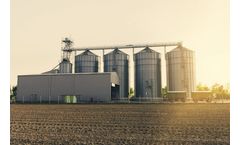Grain Industry Articles & Analysis
15 articles found
Grain carts are an effective way to reduce equipment wear and field compaction. Why waste expensive combine hours stopping to unload onto trucks at the end of the field? Or worse, exposing your operation to yield loss by compacting the ground with trucks in the field? Both these practices waste precious harvest time and put unnecessary wear on your equipment. Grain carts stay on the field, ...
Interest in the increasing carbon footprint of the dairy industry has grown considerably over the past few years and growing greenhouse gas emissions from the milk production process are a contributing factor. ...
Moulds are the most common cause of grain spoilage and can cause changes in the appearance and quality of stored grains. ...
Farm management software takes collaboration between your on-farm team and trusted advisors to the next level They say two heads are better than one. For today’s progressive farmer, this sentiment couldn’t be more true. With land values, input costs, machinery pricing and an increasingly competitive global market, maintaining an edge has never been so important to your operation. ...
At a time when grain markets continue to strain row crop revenue potential, many farmers are taking steps to do all they can to maximize productivity and yields. Excess water is a common yield robber with corn and other crops. For farmers with heavy, moisture-retaining soils, or slow draining areas in a field, installing drainage tile can improve overall productivity. Additional drainage tile ...
Farmers are now able to test the quality of their grain, and then store it on-farm to preserve its identity. Increasingly efficient trucks with advanced routing capabilities can bring identity-preserved, high quality grain from farmer to buyer. ...
Regardless of whether your yield data comes from your combine, grain cart, or from truck scales, each source has shortcomings that will not only influence your farm decisions but may also have a negative financial impact. This harvest growers will spend significant time and money chasing down accurate yield data from combine yield monitors, grain carts and/or truck scale tickets. Each of these ...
Will Hutchinson enjoys a good challenge, especially when it comes to improving production on his row crop, wheat and alfalfa farm near Murfreesboro, Tennessee. So when he saw the opportunity to leverage Ag Leader’s Hydraulic Down Force system to prevent a common problem and improve his planting operations on acres where he plants cover crops, he jumped at the chance. Two years later, ...
Moulds are the most common cause of grain spoilage and can cause changes in the appearance and quality of stored grains. ...
The world is in transition from an era of food abundance to one of scarcity. Over the last decade, world grain reserves have fallen by one third. World food prices have more than doubled, triggering a worldwide land rush and ushering in a new geopolitics of food. Food is the new oil. Land is the new gold. This new era is one of rising food prices and spreading hunger. On the demand side of the ...
Whereas rice and most wheat are consumed directly as food, corn is largely used for livestock and poultry feed and for industrial purposes. Climbing demand for corn-intensive meat, milk, and eggs plus the recent increased production of corn-based ethanol have made corn the world’s leading grain since 1998. ...
The world’s farmers produced more grain in 2011 than ever before. Estimates from the U.S. Department of Agriculture show the global grain harvest coming in at 2,295 million tons, up 53 million tons from the previous record in 2009. Consumption grew by 90 million tons over the same period to 2,280 million tons. Yet with global grain production actually falling short of consumption in 7 ...
In the Sunday November 22, 2009 issue of Outlook in the Washington Post, Lester Brown discusses the significant implications of food security in the upcoming Copenhagen Conference. As the U.N. climate-change conference in Copenhagen approaches, we are in a race between political tipping points and natural ones. Can we cut carbon emissions fast enough to keep the melting of the Greenland ice ...
For the 193 national delegations gathering in Copenhagen for the U.N. Climate Change Conference in December, the reasons for concern about climate change vary widely. For delegations from low-lying island countries, the principal concern is rising sea level. For countries in southern Europe, climate change means less rainfall and more drought. For countries of East Asia and the Caribbean, more ...
HARARE, Zimbabwe, (ENS) - Six years after President Robert Mugabe sanctioned violent invasions of Zimbabwe's commercial farmland - mostly but not entirely white owned - by landless peasants, the facts show that the so-called new farmers have failed dramatically to produce crops to feed their countrymen. The poor peasants who led the invasions, at the behest of Mugabe, have since been driven ...










